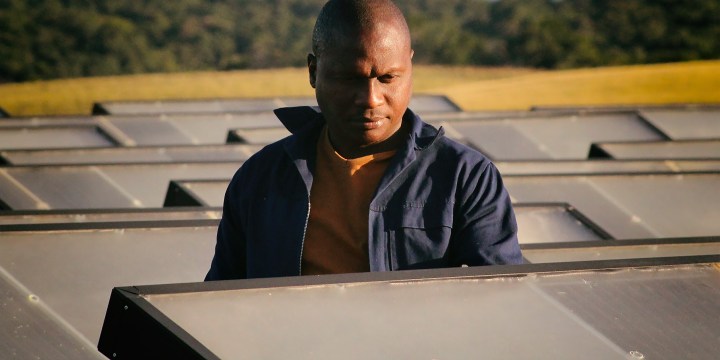JUST TRANSITION OP-ED
Social ownership of renewable energy — searching for the deck chairs long after the Titanic has sunk

Why do the European failures in transitioning to social ownership of energy get so little attention? South Africa needs to understand where potential pitfalls lie and grapple with them as a matter of urgency. Our future depends on making this work.
Among the many meanings of socialism is one that is something very different from — and a lot better than — our present global system.
A major component of this socialism, to which I subscribe, is the social ownership of the means of production. Yet I find myself writing an article critical of the social ownership of renewable energy (RE). Why?
The short answer is that the concept is important to many activists, academics and NGOs for whom it has become an alternative to both Eskom’s disintegration and the primacy enjoyed by the “market”. Their use of the notion is very general in the main — often praising some highly questionable community project, largely ignoring the multiple problems of “community” in a South African setting, overlooking global experiences, befuddling answers to energy poverty and detracting from the ever-increasing urgency of climate change.
The fact that social or community ownership is not part of government thinking — which is now openly predicated on the advancement of business that is driven by profit maximisation — is another aspect of my concern. This is of particular importance because those who champion social ownership expect government support. And then there are those who give misplaced credence to the few trade unions that still talk about the importance of social ownership.
Despite my misgivings, my sympathy is with those who champion the idea of social ownership. Being conceived by its supporters as an alternative to Eskom fundamentally shapes the kind of social ownership they promote. This begins by replacing large, vertically integrated monopolies with small enterprises. Other shared elements, according to Transition in Trouble? The Rise and Fall of Community Energy in Europe “all involve some form of popular participation in the energy transition and aim to enable or empower that participation in ways that advance the energy transition, promote social justice, and enhance the possibilities for self-determination of ordinary people. These efforts have a variety of motivations, but in the end, we think it is clear that motivations do not determine final outcomes.”
It is taken as given that popular participation must include the ability to function as a market player. This is why “final outcomes” are seldom the same as expectations, since commercial imperatives invariably become part of the social mission. But the links to a Just Transition and energy democracy are crucial.
Knowing more about what social ownership is not, is a necessary precursor to understanding what it could and should be. This article is about the former, including the fact that it is a very small player in a market dominated by large profit-driven players; the latter will follow in a separate paper.
The government’s position and the reaction of those who support social ownership
Unlike its inability to provide for even the basic essentials guaranteed in our Constitution, our government wants for little when it comes to legislation, plans and policies. There are at least 12 major Acts, amendments, policies and plans on climate change and related energy matters. (These are the National Development Plan, 2011; the National Climate Change Adaptation Strategy, 2017; South Africa’s Low Emission Development Strategy, 2020; the Climate Change Bill, 2021; A Framework for a Just Transition in South Africa, July 2022; State of the Nation Address, February 2023; the South African Renewable Energy Masterplan, July 2023; and the Electricity Regulation Amendment Act, 2023.)
The most likely candidate of these 12 for promoting some sort of social ownership would seem to be the South African Renewable Energy Masterplan (Sarem) of July this year. Apart from it being a classic case of the cart before the horse — in the absence of the long-delayed National Integrated Energy Plan — it is a (rare) collaboration between the Department of Mineral Resources and Energy, the Department of Trade, Industry and Competition and the Department of Science and Innovation. Sarem also stands out globally by explicitly addressing the problem of renewables being restricted to the rich. Sarem acknowledges that “[w]idening access to all is … socially imperative”.
The reality is that social ownership is not to be found in Sarem and community ownership is passed over in a fleeting recognition. However, so desperate are some leading NGOs for anything other than Eskom and private ownership that this neglect is actually applauded. As just one example, 350.org — an important NGO — enthuses: “We are encouraged by the mention of the implementation of pilot projects to test community-led ownership models for scale. This is a good step but the lack of detail on these initiatives is worrying.”
Even more worrying is Cosatu’s response, for, unlike NGOs, the government claims that Sarem “is a social compact between government, business and labour unions”.
Cosatu, in its joint Sarem submission with the Institute for Economic Justice, explains that it engaged consistently with the Sarem process from its inception. Yet, despite this and despite “consistently emphasising the importance of public ownership”, Sarem has made the Just Transition “synonymous with a private-investment drive and widespread market reforms in the electricity sector. Sarem primarily accepts a private pathway for the energy transition where the state, including Eskom … is focused on developing, enabling, and encouraging private investment in private generation projects.
“The idea of social and inclusive ownership is superficially introduced into the masterplan through a reliance on implementation of B-BBEE. Bid Window 5 of the REI4P included [three] private developers … which collectively accounted for 21 out of 25 [selected] projects, all of whom made use of the same B-BBEE partner, H1 Holdings. This does not constitute inclusive ownership”.
Lest it be thought that these oversights and issues have been forced on the government by the exigencies of the load shedding debacle, let it be noted that these same defects have been a consistent pattern beginning with the 20-year National Development Plan (NDP). Notwithstanding the NDP’s fantasy to “eliminate poverty and reduce inequality by 2030”, it comes as a shock that no mention is made of climate change, RE or social ownership. Not even the important COP15 in Copenhagen in 2009, or COP17 in Durban were sufficient for climate change to merit a mention.
One might have expected a lot more from Cosatu than its timid response to Sarem. Cosatu, after all, is not only in a formal alliance with the ANC but it is also the largest labour federation, with a history of resisting the apartheid state. Its response to Sarem is but a foretaste of its response to the much more challenging dismembering of Eskom.
A government notorious for the dithering of its leader is moving full steam ahead with its unbundling of Eskom, despite its formal designation as a state-owned (ie socially owned) enterprise (SOE). The most Cosatu could do in the face of this reality was to issue a self-damning press release headed “Cosatu is extremely dismayed by the latest step in unbundling Eskom”. Without any irony, it states, “Cosatu and its militant affiliate, the National Union of Mineworkers (NUM), remain deeply opposed to the electricity utility’s unbundling.”
Saying that Cosatu’s “fear’ is that the unbundling is a precursor to Eskom’s privatisation, it concludes, “Splitting Eskom into various entities and appointing additional boards is merely moving chairs on the deck of the Titanic.”
Cosatu’s empty response to what it considers a frontal attack on social ownership is also a sobering reminder of what we can expect from its leadership on the climate change front.
Coming to terms with what Cosatu has become is as painful for me, a Cosatu representative at Nedlac for several years, as it has been for the many members of the ANC that once led the struggle for a better South Africa.
The European experience and its lessons
Daily Maverick is an important platform for ideas on how to achieve a better South Africa. But the virtual debate it held on 25 August, on the subject of “Stage 6 solutions: Bottom-up responses to the energy crisis” showed our provincialism. The debate did include a speaker on social ownership and the subject did figure in the general debate, but it was clearly peripheral to the main thrust of the discussion. The event was most striking in its omission of the European experience of both social ownership and the energy crisis caused by the market before Russia’s invasion of Ukraine.
There are many important lessons arising from the European experience. The rise and fall of social ownership, the public cost of enabling the private provision of electricity and the presumed transition to RE are among them. Yet nothing was said about any of this, despite the extensive coverage available over the years. Above all, there is the document titled Transition in Trouble? The Rise and Fall of Community Energy in Europe published by Trade Unions for Energy Democracy and written by US-based Sean Sweeny, John Treat and Irene HongPing Shen that has been widely circulated in South Africa by the Alternative Information and Development Centre (AIDC) where I work — and the Energy Governance SA network, among others. Unless otherwise stated, I shall be drawing on this 45-page paper.
At a debate at the AIDC, on “A progressive response to energy transitions,” (29 July 23), Professor Mark Swilling held up Germany and Denmark as countries from which South Africa could learn about the social or community ownership of RE. It would be nice to agree with Swilling (who has a longstanding close relationship with AIDC). However, Transition in Trouble? tells a different story.
It places both countries squarely in a Europe where the distance between the early expectations of government-supported “energy citizenship” and the reality on the ground is “vast and growing”. In the early years, the growth of RE and the expansion of citizen ownership seemed so inseparable and the falling costs of wind and solar energy so enduring that “[a] radical … shift in control away from large energy companies … seemed not only possible but … even imminent”.
The problem was that this transition relied heavily on state subsidies, mainly in the form of feed-in tariffs (FITs). The transition ended when energy companies added the costs of these FITs to user bills — public and business alike — which, in England, for instance, comprised about 20% of energy bills. The European Commission calculated that for 2012 alone FIT payments added €40-billion to the electricity bills of European users. Electricity bills were further inflated when utilities began recovering “system costs”, such as grid upgrades and extensions from retail charges.
The uniform response across Europe was to abandon FITs. David lost against Goliath in the unequal competition between energy citizens and the larger for-profit companies that, moreover, enjoyed state protection. As early as 2014, the European Commission introduced its revised Guidelines on state aid for environmental protection and energy 2014-2020 to address “serious market distortions.” According to the commission, it was “time for renewables to join the market”.
The ensuing abandonment of FITs across Europe and elsewhere, as the Transition in Trouble? notes, “compelled Europe to slam the brakes on the transition to renewables”.
Denmark and Germany — the poster countries for community ownership — provide specificity to the above pattern, which can’t be detailed here (but are in Transition in Trouble?).
Concurrent with these developments in Europe and other parts of the world, the profit-led transition to renewables collided with the more important profit-led imperative of profit maximisation. The increasing cheapness of RE — which one would expect to be applauded — resulted in declining investment in them across the world.
Falling bid prices, the outcome of competition among the large companies, resulted in a 75% reduction in the price of solar PV from 2009 to 2018, with wind prices falling by 50%. But for the world dominated by profit maximisation, this was bad news. Europe experienced a dramatic decline in RE investments, with global investments also trending downwards. Twenty years of the “market” resulted in what unregulated or insufficiently regulated markets always do: they produce oligopolies — the Big Five, in the case of Europe’s RE market. These giants all face what has been called the “utility death spiral”.
Falling electricity sales, along with a combination of falling profits and high debt levels have led to the downgrading of many utilities’ credit ratings. The net income of Germany’s RWE fell by 83% in 2018. France’s EDF and Germany’s E.ON did just slightly better, with losses of “only” 65% and 22%, respectively. This was despite government rescue interventions, such as “capacity payments”, that is, “insurance” payments to electricity generators allowing them to keep their generation capacity even when it is not needed.
China, the world’s largest RE supplier, has not been exempt from these market realities. Following the European lead, China reduced its FIT support in 2018. This prompted an immediate crisis in the Chinese solar sector. According to UNEP/BNEF, China remains the world’s leading investor, but its investment in clean energy in 2018 was down by 38% from 2017 because of these policy changes. Investment in solar, in particular, fell by 53%.
The worry, for the rest of us, is that global investment in RE is far short of what is required to meet the Paris climate targets. It remains at roughly one-third of the required $1-trillion per year, an amount called for by leading policy voices. Total investment in new capacity for 2019 went down some 12% from the record-high figure reached in 2012.
Transition in trouble
Russia’s invasion of Ukraine has made the situation even worse. Transition in Trouble? was published in March 2020. We can now remove the question mark. Nato — principally the US, EU and Britain — is demonstrating that for it the war against climate change is no more than an optional extra, with unambiguous primacy being given to short-term geopolitical advantages. The energy crisis caused by Nato’s decision to use Ukraine in its cold war against Russia has meant more support for RE. But it has also meant even greater respectability for fossil fuels. Headlines like “Global coal demand set to remain at record levels in 2023” by the International Energy Agency (IEA) convey the message. It has also given some respectability to Africa’s dash for gas.
Speaking at the recent third annual Southern Africa Oil and Gas Conference, Energy Minister Gwede Mantashe made the valid point that fossil fuels can’t be phased out overnight. The conference, however, wasn’t about the phasing-out of fossil fuels but rather a call for their expansion. Indeed, Mantashe blamed allegedly CIA-funded NGOs for depriving South Africa of R288-billion investments in fossil fuel projects.
He added that optimal development of oil and gas resources had the potential to transform the country’s economy and could lead to gross domestic product (GDP) growth of up to 8%, from its current rate of less than 1%. To this end, he can celebrate the high court decision in Limpopo on 15 September that found that new coal mines take precedence over the protection of recognised high biodiversity value areas.
The Statistical Review of World Energy 2023 provides the latest global data. Non-hydro RE accounted for 7.5% of energy consumption in 2022, up from 6.7% in 2021. This RE consumption has grown at roughly 12.6% (and power generation by 14.7%), which is impressive until we remember that the aim is to displace energy consumption of fossil fuels which are all growing too. While this was a modest growth of 0.5%, they still accounted for 82.7% of all energy consumed. A particularly worrying but predictable data point is that CO2 emissions rose by 0.9% in 2022, higher than the 0.6% average over the past decade. RE does much better in power generation, where it now accounts for 14.4% of total generation, but remains well behind coal (35.4%) and gas (22.7%).
And then there is the long-known but only recently publicly acknowledged problem of grid capacity, not only in South Africa but across the world, as a recent Daily Maverick article makes clear. In Britain, for example, there is 200GW worth of new electricity waiting to come online — which is more than three times South Africa’s total installed capacity. The waiting times, however, are up to 15 years.
Globally, it is estimated that grid capacity needs to more than double by 2050, requiring an investment of almost $550-billion a year by 2030, accounting for as much as 30% of energy transition costs. Speaking specifically about South Africa, Council for Scientific and Industrial Research senior energy researcher Monique le Roux, noted, “This is one of the hidden costs of renewable energy generation that is not properly accounted for and planned for and was not included in the IRP 2019 — it is going to increase the cost of renewable energy considerably in future.”
Even if investors were to be found to finance this cost, the grid is yet another reason for caution when speaking about the presumed transition to RE.
Transforming the transition in time to make climate change (sort of) compatible with humanity
All this could just lead us to a fatalistic acceptance of a doomed humanity. But it isn’t the inescapable response to bad news. What if there are different answers? Ones that won’t magic climate change away, but do provide a realistic alternative to the inevitability of humanity’s climate suicide?
What if Neil Overy’s major paper on The Role of Ownership in a Just Energy Transition of 2018 is wrong when it concludes: “What is clear is that Eskom can no longer continue in its vertically integrated monopoly form”?
What if Swilling is right when he attributes what he calls South Africa’s “disorderly transition”, not to the consequences of the Russian invasion, but rather to South Africa’s new emphasis on market RE? “Ironically,” he notes in a recent Daily Maverick article, “by resisting state leadership of the renewables solution that can potentially deliver cheap energy to all quicker than any other technology, the government has lost control of a market-driven solution enabled by sophisticated credit solutions created by the banks and turbo-charged by tax incentives.”
What if an orderly transition to RE meant a state committed to proper social ownership rather than market-driven solutions? “What if the real enemy all along was the privatisation, marketisation, and liberalisation of the system itself?” asks Transition in Trouble?
“This process,” it continues, “turned electricity generation into a commercial battleground. This forced even formally public companies to behave as commercial actors, concerned about market share, revenue streams, and delivering dividends to shareholders. Why would these interests embrace renewable energy when to do so would intensify their own death spiral”?
I shall return to these and other specifically South African-related issues in a separate discussion. The correct diagnosis of a life-threatening condition doesn’t necessarily mean a cure, but without an accurate diagnosis there is no chance of a cure. There is a diagnosis to be made that is different from the many already on offer, in which social ownership is central and which goes beyond RE and climate change itself.
There’s a dual imperative for big and bold thinking. Climate change requires both ambitions. So, too, does the significant reversal of our triple plagues of poverty, unemployment and inequality. A foremost challenge will be to Swilling’s bold assertion, “The dream of a revived, centralised, state-owned energy generation, transmission and distribution system will never be realised.”
As South Africans, we have two good reasons never to say never. Until it happened, 1994 was a “never in my lifetime” assertion. And who would have believed the speed with which the ANC moved from liberator to promoter and defender of oppression? DM
Jeff Rudin works at the Alternative Information & Development Centre (AIDC).

















An interesting piece Jeff, and agreed that there are significant limitations to community owned renewable energy. However, is it really accurate to characterise 350 as “so desperate… for anything other than Eskom and private ownership” when the very SAREM submission you mention from them includes an entire section on the need for a Green New Eskom, which is a campaign they and the Climate Justice Coalition have been leading on?
An important thought-piece. In a socially splintered and weak state, how much social ownership is possible? And could attention to social ownership help rebuild social compacts and state capacity? Just one challenge to the gloomy picture painted of social ownership of RE in Europe: I read in a respected German paper just this week that in the northern Land of Schleswig-Holstein, 90% of wind turbines are owned by citizen co-operatives. Not exactly socialism, but also not all distant large corporates.